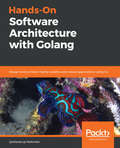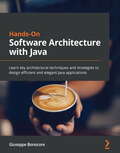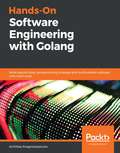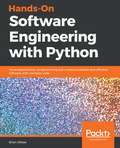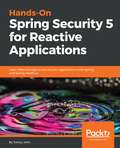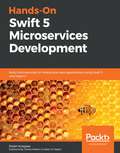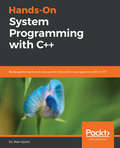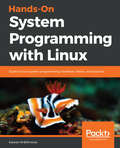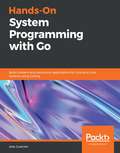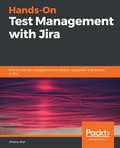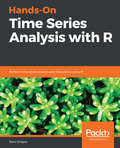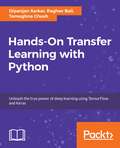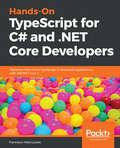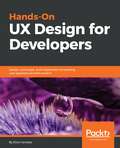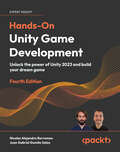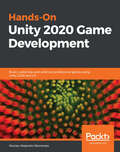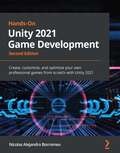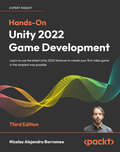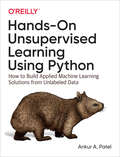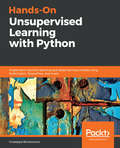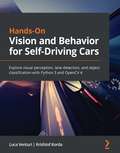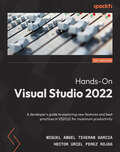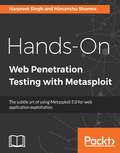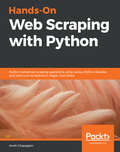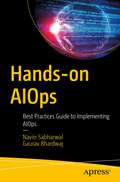- Table View
- List View
Hands-On Software Architecture with Golang: Design And Architect Highly Scalable And Robust Applications Using Go
by Jyotiswarup RaiturkarThis book is for software developers, architects and CTOs looking to use Go in their software architecture. The book assumes general programming knowledge and architecture concepts. Familiarity with Go is not required and programming constructs are introduced with concepts.
Hands-On Software Architecture with Java
by Giuseppe BonocoreThis book is for Java software engineers who want to become software architects and learn everything a modern software architect needs to know. The book is also for software architects, technical leaders, vice presidents of software engineering, and CTOs looking to extend their knowledge and stay up to date with the latest developments in the field of software architecture.
Hands-On Software Engineering with Golang: Move beyond basic programming to design and build reliable software with clean code
by Achilleas AnagnostopoulosExplore software engineering methodologies, techniques, and best practices in Go programming to build easy-to-maintain software that can effortlessly scale on demand Key Features Apply best practices to produce lean, testable, and maintainable Go code to avoid accumulating technical debt Explore Go's built-in support for concurrency and message passing to build high-performance applications Scale your Go programs across machines and manage their life cycle using Kubernetes Book Description Over the last few years, Go has become one of the favorite languages for building scalable and distributed systems. Its opinionated design and built-in concurrency features make it easy for engineers to author code that efficiently utilizes all available CPU cores. This Golang book distills industry best practices for writing lean Go code that is easy to test and maintain, and helps you to explore its practical implementation by creating a multi-tier application called Links 'R' Us from scratch. You'll be guided through all the steps involved in designing, implementing, testing, deploying, and scaling an application. Starting with a monolithic architecture, you'll iteratively transform the project into a service-oriented architecture (SOA) that supports the efficient out-of-core processing of large link graphs. You'll learn about various cutting-edge and advanced software engineering techniques such as building extensible data processing pipelines, designing APIs using gRPC, and running distributed graph processing algorithms at scale. Finally, you'll learn how to compile and package your Go services using Docker and automate their deployment to a Kubernetes cluster. By the end of this book, you'll know how to think like a professional software developer or engineer and write lean and efficient Go code. What you will learn Understand different stages of the software development life cycle and the role of a software engineer Create APIs using gRPC and leverage the middleware offered by the gRPC ecosystem Discover various approaches to managing package dependencies for your projects Build an end-to-end project from scratch and explore different strategies for scaling it Develop a graph processing system and extend it to run in a distributed manner Deploy Go services on Kubernetes and monitor their health using Prometheus Who this book is for This Golang programming book is for developers and software engineers looking to use Go to design and build scalable distributed systems effectively. Knowledge of Go programming and basic networking principles is required.
Hands-On Software Engineering with Python: Move beyond basic programming and construct reliable and efficient software with complex code
by Brian AllbeeExplore various verticals in software engineering through high-end systems using PythonKey FeaturesMaster the tools and techniques used in software engineeringEvaluates available database options and selects one for the final Central Office system-componentsExperience the iterations software go through and craft enterprise-grade systemsBook DescriptionSoftware Engineering is about more than just writing code—it includes a host of soft skills that apply to almost any development effort, no matter what the language, development methodology, or scope of the project. Being a senior developer all but requires awareness of how those skills, along with their expected technical counterparts, mesh together through a project's life cycle. This book walks you through that discovery by going over the entire life cycle of a multi-tier system and its related software projects. You'll see what happens before any development takes place, and what impact the decisions and designs made at each step have on the development process. The development of the entire project, over the course of several iterations based on real-world Agile iterations, will be executed, sometimes starting from nothing, in one of the fastest growing languages in the world—Python. Application of practices in Python will be laid out, along with a number of Python-specific capabilities that are often overlooked. Finally, the book will implement a high-performance computing solution, from first principles through complete foundation.What you will learnUnderstand what happens over the course of a system's life (SDLC)Establish what to expect from the pre-development life cycle stepsFind out how the development-specific phases of the SDLC affect developmentUncover what a real-world development process might be like, in an Agile wayFind out how to do more than just write the codeIdentify the existence of project-independent best practices and how to use themFind out how to design and implement a high-performance computing processWho this book is forHands-On Software Engineering with Python is for you if you are a developer having basic understanding of programming and its paradigms and want to skill up as a senior programmer. It is assumed that you have basic Python knowledge.
Hands-On Spring Security 5 for Reactive Applications: Learn effective ways to secure your applications with Spring and Spring WebFlux
by Tomcy JohnSecure your Java applications by integrating the Spring Security framework in your codeKey FeaturesProvide authentication, authorization and other security features for Java applications.Learn how to secure microservices, cloud, and serverless applications easilyUnderstand the code behind the implementation of various security featuresBook DescriptionSecurity is one of the most vital concerns for any organization. The complexity of an application is compounded when you need to integrate security with existing code, new technology, and other frameworks. This book will show you how to effectively write Java code that is robust and easy to maintain.Hands-On Spring Security 5 for Reactive Applications starts with the essential concepts of reactive programming, Spring Framework, and Spring Security. You will then learn about a variety of authentication mechanisms and how to integrate them easily with the Spring MVC application. You will also understand how to achieve authorization in a Spring WebFlux application using Spring Security.You will be able to explore the security confgurations required to achieve OAuth2 for securing REST APIs and integrate security in microservices and serverless applications. This book will guide you in integrating add-ons that will add value to any Spring Security module.By the end of the book, you will be proficient at integrating Spring Security in your Java applicationsWhat you will learnUnderstand how Spring Framework and Reactive application programming are connectedImplement easy security confgurations with Spring Security expressionsDiscover the relationship between OAuth2 and OpenID ConnectSecure microservices and serverless applications with SpringIntegrate add-ons, such as HDIV, Crypto Module, and CORS supportApply Spring Security 5 features to enhance your Java reactive applicationsWho this book is forIf you are a Java developer who wants to improve application security, then this book is for you. A basic understanding of Spring, Spring Security framework, and reactive applications is required to make the most of the book.
Hands-On Swift 5 Microservices Development: Build microservices for mobile and web applications using Swift 5 and Vapor 4
by Ralph Kuepper Tanner NelsonLearn to design and deploy fully functioning microservices for your applications from scratch using Swift, Docker, and AWS Key Features Understand server-side Swift development concepts for building your first microservice Build microservices using Vapor 4 and deploy them to the cloud using Docker Learn effective techniques for enhancing maintainability and stability of your Swift applications Book Description The capabilities of the Swift programming language are extended to server-side development using popular frameworks such as Vapor. This enables Swift programmers to implement the microservices approach to design scalable and easy-to-maintain architecture for iOS, macOS, iPadOS, and watchOS applications. This book is a complete guide to building microservices for iOS applications. You'll start by examining Swift and Vapor as backend technologies and compare them to their alternatives. The book then covers the concept of microservices to help you get started with developing your first microservice. Throughout this book, you'll work on a case study of writing an e-commerce backend as a microservice application. You'll understand each microservice as it is broken down into details and written out as code throughout the book. You'll also become familiar with various aspects of server-side development such as scalability, database options, and information flow for microservices that are unwrapped in the process. As you advance, you'll get to grips with microservices testing and see how it is different from testing a monolith application. Along the way, you'll explore tools such as Docker, Postman, and Amazon Web Services. By the end of the book, you'll be able to build a ready-to-deploy application that can be used as a base for future applications. What you will learn Grasp server-side Swift development concepts using practical examples Understand the microservices approach and why Swift is a great choice for building microservices Design and structure mobile and web applications using microservices architecture Discover the available database options and understand which one to choose Scale and monitor your microservices Use Postman to automate testing for your microservices API Who this book is for The book is for iOS, iPadOS, and macOS developers and Swift programmers who want to understand how Swift can be used for building microservices. The book assumes familiarity with Swift programming and the fundamentals of the web, including how APIs work.
Hands-On System Programming with C++: Build Performant And Concurrent Unix And Linux Systems With C++17
by Dr Rian QuinnIf you are a developer who has intermediate knowledge of C++ but little to no knowledge of UNIX and Linux system programming and want to learn system programming with C++, this book is for you.
Hands-On System Programming with Linux: Explore Linux system programming interfaces, theory, and practice
by Kaiwan N BillimoriaGet up and running with system programming concepts in LinuxKey FeaturesAcquire insight on Linux system architecture and its programming interfacesGet to grips with core concepts such as process management, signalling and pthreadsPacked with industry best practices and dozens of code examplesBook DescriptionThe Linux OS and its embedded and server applications are critical components of today’s software infrastructure in a decentralized, networked universe. The industry's demand for proficient Linux developers is only rising with time. Hands-On System Programming with Linux gives you a solid theoretical base and practical industry-relevant descriptions, and covers the Linux system programming domain. It delves into the art and science of Linux application programming— system architecture, process memory and management, signaling, timers, pthreads, and file IO.This book goes beyond the use API X to do Y approach; it explains the concepts and theories required to understand programming interfaces and design decisions, the tradeoffs made by experienced developers when using them, and the rationale behind them. Troubleshooting tips and techniques are included in the concluding chapter.By the end of this book, you will have gained essential conceptual design knowledge and hands-on experience working with Linux system programming interfaces.What you will learnExplore the theoretical underpinnings of Linux system architectureUnderstand why modern OSes use virtual memory and dynamic memory APIsGet to grips with dynamic memory issues and effectively debug themLearn key concepts and powerful system APIs related to process managementEffectively perform file IO and use signaling and timersDeeply understand multithreading concepts, pthreads APIs, synchronization and schedulingWho this book is forHands-On System Programming with Linux is for Linux system engineers, programmers, or anyone who wants to go beyond using an API set to understanding the theoretical underpinnings and concepts behind powerful Linux system programming APIs. To get the most out of this book, you should be familiar with Linux at the user-level logging in, using shell via the command line interface, the ability to use tools such as find, grep, and sort. Working knowledge of the C programming language is required. No prior experience with Linux systems programming is assumed.
Hands-On Systems Programming with Go: Build modern and concurrent applications for Unix and Linux systems using Golang
by Alex GuerrieriIf you are a developer who has intermediate knowledge of Go but little to no knowledge of UNIX and Linux system programming and want to learn and master system programming with Go, this book is for you.
Hands-On Test Management with JIRA: End-to-end Test Management With Zephyr, Synapsert, And Jenkins In Jira
by Afsana AtarThis book is for any quality assurance professional, software project manager or test manager interested in learning to implement test management best practices in their team or organization.
Hands-On Time Series Analysis with R: Perform time series analysis and forecasting using R
by Rami KrispinBuild efficient forecasting models using traditional time series models and machine learning algorithms.Key FeaturesPerform time series analysis and forecasting using R packages such as Forecast and h2oDevelop models and find patterns to create visualizations using the TSstudio and plotly packagesMaster statistics and implement time-series methods using examples mentionedBook DescriptionTime series analysis is the art of extracting meaningful insights from, and revealing patterns in, time series data using statistical and data visualization approaches. These insights and patterns can then be utilized to explore past events and forecast future values in the series.This book explores the basics of time series analysis with R and lays the foundations you need to build forecasting models. You will learn how to preprocess raw time series data and clean and manipulate data with packages such as stats, lubridate, xts, and zoo. You will analyze data and extract meaningful information from it using both descriptive statistics and rich data visualization tools in R such as the TSstudio, plotly, and ggplot2 packages. The later section of the book delves into traditional forecasting models such as time series linear regression, exponential smoothing (Holt, Holt-Winter, and more) and Auto-Regressive Integrated Moving Average (ARIMA) models with the stats and forecast packages. You'll also cover advanced time series regression models with machine learning algorithms such as Random Forest and Gradient Boosting Machine using the h2o package.By the end of this book, you will have the skills needed to explore your data, identify patterns, and build a forecasting model using various traditional and machine learning methods.What you will learnVisualize time series data and derive better insightsExplore auto-correlation and master statistical techniquesUse time series analysis tools from the stats, TSstudio, and forecast packagesExplore and identify seasonal and correlation patternsWork with different time series formats in RExplore time series models such as ARIMA, Holt-Winters, and moreEvaluate high-performance forecasting solutionsWho this book is forHands-On Time Series Analysis with R is ideal for data analysts, data scientists, and all R developers who are looking to perform time series analysis to predict outcomes effectively. A basic knowledge of statistics is required; some knowledge in R is expected, but not mandatory.
Hands-On Transfer Learning with Python: Implement advanced deep learning and neural network models using TensorFlow and Keras
by Raghav Bali Dipanjan Sarkar Tamoghna GhoshDeep learning simplified by taking supervised, unsupervised, and reinforcement learning to the next level using the Python ecosystemKey FeaturesBuild deep learning models with transfer learning principles in Pythonimplement transfer learning to solve real-world research problemsPerform complex operations such as image captioning neural style transferBook DescriptionTransfer learning is a machine learning (ML) technique where knowledge gained during training a set of problems can be used to solve other similar problems. The purpose of this book is two-fold; firstly, we focus on detailed coverage of deep learning (DL) and transfer learning, comparing and contrasting the two with easy-to-follow concepts and examples. The second area of focus is real-world examples and research problems using TensorFlow, Keras, and the Python ecosystem with hands-on examples. The book starts with the key essential concepts of ML and DL, followed by depiction and coverage of important DL architectures such as convolutional neural networks (CNNs), deep neural networks (DNNs), recurrent neural networks (RNNs), long short-term memory (LSTM), and capsule networks. Our focus then shifts to transfer learning concepts, such as model freezing, fine-tuning, pre-trained models including VGG, inception, ResNet, and how these systems perform better than DL models with practical examples. In the concluding chapters, we will focus on a multitude of real-world case studies and problems associated with areas such as computer vision, audio analysis and natural language processing (NLP).By the end of this book, you will be able to implement both DL and transfer learning principles in your own systems.What you will learnSet up your own DL environment with graphics processing unit (GPU) and Cloud support Delve into transfer learning principles with ML and DL modelsExplore various DL architectures, including CNN, LSTM, and capsule networks Learn about data and network representation and loss functionsGet to grips with models and strategies in transfer learning Walk through potential challenges in building complex transfer learning models from scratch Explore real-world research problems related to computer vision and audio analysis Understand how transfer learning can be leveraged in NLPWho this book is forHands-On Transfer Learning with Python is for data scientists, machine learning engineers, analysts and developers with an interest in data and applying state-of-the-art transfer learning methodologies to solve tough real-world problems. Basic proficiency in machine learning and Python is required.
Hands-On TypeScript for C# and .NET Core Developers: Transition from C# to TypeScript 3.1 and build applications with ASP.NET Core 2
by Francesco AbbruzzeseDiscover how TypeScript allows you to build modern client-rich applications, thanks to its object-oriented capabilities and third-party tools like Angular and Web APIsKey FeaturesMake a seamless transition to using TypeScript 3.1 in your development stackWork with TypeScript 3.1 in your ASP.NET Core projects to build rich applications that are easy to maintainBuild, test, and integrate your own TypeScript library in real-world projectsBook DescriptionWriting clean, object-oriented code in JavaScript gets trickier and complex as the size of the project grows. This is where Typescript comes into the picture; it lets you write pure object-oriented code with ease, giving it the upper hand over JavaScript. This book introduces you to basic TypeScript concepts by gradually modifying standard JavaScript code, which makes learning TypeScript easy for C# ASP.NET developers.As you progress through the chapters, you'll cover object programming concepts, such as classes, interfaces, and generics, and understand how they are related to, and similar in, both ES6 and C#. You will also learn how to use bundlers like WebPack to package your code and other resources. The book explains all concepts using practical examples of ASP.NET Core projects, and reusable TypeScript libraries. Finally, you'll explore the features that TypeScript inherits from either ES6 or C#, or both of them, such as Symbols, Iterables, Promises, and Decorators.By the end of the book, you'll be able to apply all TypeScript concepts to understand the Angular framework better, and you'll have become comfortable with the way in which modules, components, and services are defined and used in Angular. You'll also have gained a good understanding of all the features included in the Angular/ASP.NET Core Visual Studio project template.What you will learnOrganize, test, and package large TypeScript code baseAdd TypeScript to projects using TypeScript declaration filesPerform DOM manipulation with TypeScriptDevelop Angular projects with the Visual Studio Angular project templateDefine and use inheritance, abstract classes, and methodsLeverage TypeScript-type compatibility rulesUse WebPack to bundle JavaScript and other resources such as CSS to improve performanceBuild custom directives and attributes, and learn about animationsWho this book is forIf you’re a C# or .NET developer looking for an easy accessible way of learning TypeScript, this book is for you.
Hands-On UX Design for Developers: Design, prototype, and implement compelling user experiences from scratch.
by Elvis CanzibaLearn every step you need for product design and developmentKey FeaturesExplore all the tools that you need to be a complete UX designerCode the product designs you’ve created to become a full-stack designerBuild an amazing portfolio with real-world projectsBook DescriptionDesigning user experience (UX) is one of the most important aspects of a project, as it has a direct effect on how customers think of your company. The process of designing a user experience is one of the most challenging yet rewarding aspects of product development. Hands-On UX Design for Developers will teach you how to create amazing user experiences for products from scratch.This book starts with helping you understand the importance of a good UX design and the role of a UX designer. It will take you through the different stages of designing a UX and the application of various principles of psychology in UX design. Next, you will learn how to conduct user research and market research, which is crucial to creating a great UX. You will also learn how to create user personas and use it for testing. This book will help you gain the ability to think like a UX designer and understand both sides of product development: design and coding. You will explore the latest tools, such as Sketch, Balsamiq, and Framer.js, to create wireframes and prototypes. The concluding chapters will take you through designing your UI, dealing with big data while designing a UX, and the fundamentals of frontend. Finally, you'll prepare your portfolio and become job ready in the UX arena.What you will learnWhat UX is and what a UX designer doesExplore the UX Process and science of making products user-friendlyCreate user interfaces and learn which tools to useUnderstand how your design works in the real worldCreate UI interaction, animation, wireframes, and prototypesDesign a product with users in mindDevelop a personal portfolio and be well-prepared to join the UX worldWho this book is forHands-On UX/UI Design for Developers is for web designers who have knowledge of basic UX design principles.
Hands-On Unity Game Development: Unlock the power of Unity 2023 and build your dream game
by Nicolas Alejandro Borromeo Juan Gabriel SalasUnlock game development mastery with Unity 2023! This book takes you from conception to publication, equipping you with the key tools and techniques you need to bring your gaming vision to life.Key FeaturesLearn the fundamentals of Unity 2023 and create your dream gameExplore the world of augmented reality (AR) to create captivating mobile gamesPropel game performance and player experience to new heights with Data-Oriented Technology Stack (DOTS) insightsBook DescriptionTake your game development skills to the next level. Dive into the world of game creation confidently by elevating your game development skills. This book is your definitive and practical guide to unlocking the full potential of Unity 2023. Every chapter is designed to empower you to customize your own game, not just replicate what's in the book. This new edition includes immersive Augmented Reality (AR) experiences and performance optimization with Data-Oriented Technology Stack (DOTS). From Scene Creation to seamless Assert Integration, dive into C# programming and Visual Scripting with step-by-step guidance for beginners. Implement dynamic gameplay elements, including movement, spawning, physics, and health systems. Delve deeper into the magic of Game AI through sensor-driven decision-making with Finite State Machines (FSMs). Elevate your visuals with materials, shaders, textures, and particle systems. Optimize performance with Profiler insights and debug your game for a polished final product. Whether you're a beginner or a seasoned pro, this book will equip you with the skills needed to bring your game ideas to life.What you will learnBuild a game that includes gameplay, player and non-player characters, assets, animations, and moreLearn C# and Visual Scripting to customize player movements, the UI, and game physicsImplement Game AI to build a fully functional enemy capable of detecting and attackingUse Universal Render Pipeline (URP) to create high-quality visuals with UnityCreate win-lose conditions using design patterns such as Singleton and Event ListenersImplement realistic and dynamic physics simulations with the new Physics SystemWho this book is forBoth game and non-game developers looking to migrate or start building 3D games in Unity will find this Unity game development book useful. While you can still follow along without prior programming experience, knowing C# fundamentals will help you make the most of this book.
Hands-On Unity 2020 Game Development: Build, customize, and optimize professional games using Unity 2020 and C#
by Nicolas Alejandro BorromeoBuild immersive game experiences using the new Unity 2020 features with this practical guide Key Features Unleash the capabilities of C# scripting for creating immersive UI, graphics, Game AI agents and much more Explore Unity's latest tools, including Universal Render Pipeline, Shader Graph, and VFX graph, to enhance graphics and animation Get started with building augmented reality experience using Unity's AR Foundation Book Description Over the years, the Unity game engine has extended its scope from just being about creating video games to building AR/VR experiences, complex simulations, real-time realistic rendering, films, and serious games for training and education. Its features for implementing gameplay, graphics, and customization using C# programming make Unity a comprehensive platform for developing professional-level, rich experiences. With this book, you'll be able to build impressive Unity projects in a step-by-step manner and apply your knowledge of Unity concepts to create a real-world game. Complete with hands-on tutorials and projects, this easy-to-follow guide will show you how to develop your first complete game using a variety of Unity tools. As you make progress, you'll learn how to make the most of the Unity Editor and create scripts using the C# programming language. This Unity game development book will then take you through integrating graphics, sound, and animations and manipulating physics to create impressive mechanics for your games. You'll also learn how to code a simple AI agent to challenge the user and use profiling tools to ensure that the code runs in a performant way. Finally, you'll get to grips with Unity's AR Foundation for creating AR experiences for 3D apps and games. By the end of this book, you'll have developed a complete game and will have built a solid foundation using Unity's tooling ecosystem to develop game projects of any scale. What you will learn Write scripts for customizing various aspects of a game, such as physics, gameplay, and UI Program rich shaders and effects using Unity's new Shader Graph and Universal Render Pipeline Implement postprocessing to increase graphics quality with full-screen effects Create rich particle systems for your Unity games from scratch using VFX Graph and Shuriken Add animations to your game using the Animator, Cinemachine, and Timeline Implement game artificial intelligence (AI) to control character behavior Detect and fix optimization issues using profilers and batching Who this book is for This book is for game developers looking to migrate to the Unity game engine. If you are a developer with some exposure to Unity, this book will help you explore its latest features. Prior experience with C# programming is required to get the most out of the book.
Hands-On Unity 2021 Game Development: Create, customize, and optimize your own professional games from scratch with Unity 2021, 2nd Edition
by Nicolas Alejandro BorromeoAchieve mesmerizing game experiences using the latest Unity 2021 features by following a practical approach to building professional gamesKey FeaturesUnleash the capabilities of C# scripting to create UIs, graphics, game AI agents and moreExplore Unity's latest tools, including Universal Render Pipeline, Shader Graph, UI Toolkit, Visual Scripting, and VFX graph, to enhance graphics and animationBuild an AR experience using Unity's AR FoundationBook DescriptionUnity is a comprehensive yet simple suite of tools for developing video games. You can use Unity to not only create video games, but also AR/VR experiences, complex simulations, real-time realistic rendering, films, and practical games for training and education. With this book, you will get to grips with creating a full game from the ground up, building it step-by-step and applying your knowledge as you progress. Complete with hands-on tutorials and projects, this easy-to-follow guide will teach you how to develop the game using several Unity tools. As you advance, you will learn how to use the Unity engine, create simple scripts using C#, integrate graphics, sound, and animations, and manipulate physics to create interesting mechanics for your game. You'll be able to apply all the knowledge that you gain to a real-world game. Later chapters will show you how to code a simple AI agent to challenge the user and use profiling tools to ensure that the code runs efficiently. Finally, you'll work with Unity's AR tools to create AR experiences for 3D apps and games. By the end of this Unity book, you will have created a complete game and built a solid foundation in using a wide variety of Unity tools.What you will learnExplore both C# and Visual Scripting tools to customize various aspects of a game, such as physics, gameplay, and the UIProgram rich shaders and effects using Unity's new Shader Graph and Universal Render PipelineImplement postprocessing to improve graphics quality with full-screen effectsCreate rich particle systems for your Unity games from scratch using VFX Graph and ShurikenAdd animations to your game using the Animator, Cinemachine, and TimelineUse the brand new UI Toolkit package to create user interfacesImplement game AI to control character behaviorWho this book is forThis Unity engine book is for game developers looking to migrate to the Unity game engine. If you are a developer with some exposure to Unity, this book will help you explore its latest features. Prior experience with C# programming is required to get the most out of this Unity game development book.
Hands-On Unity 2022 Game Development: Learn to use the latest Unity 2022 features to create your first video game in the simplest way possible, 3rd Edition
by Nicolas Alejandro BorromeoCreate, customize, and optimize your own professional games from scratch with Unity 2022Includes invitation to join the online Unity Game Development community to read the book alongside Unity developers/C# programmers and Nicolas Borromeo.Purchase of the print or Kindle book includes a free eBook in the PDF format.Key FeaturesCreate the game prototype and learn the fundamentals of Unity editor to build scenes, objects and import objectsAdd interactivity, win/lose conditions, sound, graphics and artificial intelligence using C# and visual scriptingImprove the game graphics, user interface, add visual effects and animations using Animator, Cinemachine, and TimelineBook DescriptionUnity is a cross-platform game engine that provides you with powerful but simple-to-use features to solve the most common problems in Game Development, such as rendering, animation, physics, sound, and effects. You'll learn to use these features to create simple but complete games (and all the nuances needed to handle Unity).Complete with hands-on tutorials and projects, this book will teach you to use the Unity game engine, create C# and visual scripts, integrate graphics, sound, and animations, and manipulate physics to create interesting mechanics for your game. You'll then code a simple AI agent to challenge the user and work with profiling tools to ensure code efficiency.Finally, you'll work with Unity's AR tools to create AR experiences for 3D apps and games before publishing them to the world.If you are interested in creating impressive, commercial-quality games that are playable on a variety of platforms, then you've come to the right place.What you will learnBuild a game prototype that includes gameplay, player and non-player characters, assets, animations, and moreSet up and navigate the game engine to dive into the Unity Editor and discover unique and new features released in 2022Learn both C# and Visual Scripting to customize player movements, the user interface, and game physicsApply shaders to improve your game graphics using Shader Graph and Universal Render Pipeline (URP)Create win-lose conditions for the game by using design patterns such as Singleton and Event ListenersImplement Game AI to build a fully functional enemy capable of detecting and attacking the playerDebug, test, optimize, and create an executable version of the game to share with your friendsWho this book is forBoth game and non-game developers who wish to migrate or start building 3D games in Unity will find this book useful. While you'll still able to follow along if you don't have any programming experience, knowing the fundamentals of C# programming will help you get the most out of this book.
Hands-On Unsupervised Learning Using Python: How to Build Applied Machine Learning Solutions from Unlabeled Data
by Ankur A. PatelMany industry experts consider unsupervised learning the next frontier in artificial intelligence, one that may hold the key to general artificial intelligence. Since the majority of the world's data is unlabeled, conventional supervised learning cannot be applied. Unsupervised learning, on the other hand, can be applied to unlabeled datasets to discover meaningful patterns buried deep in the data, patterns that may be near impossible for humans to uncover.Author Ankur Patel shows you how to apply unsupervised learning using two simple, production-ready Python frameworks: Scikit-learn and TensorFlow using Keras. With code and hands-on examples, data scientists will identify difficult-to-find patterns in data and gain deeper business insight, detect anomalies, perform automatic feature engineering and selection, and generate synthetic datasets. All you need is programming and some machine learning experience to get started.Compare the strengths and weaknesses of the different machine learning approaches: supervised, unsupervised, and reinforcement learningSet up and manage machine learning projects end-to-endBuild an anomaly detection system to catch credit card fraudClusters users into distinct and homogeneous groupsPerform semisupervised learningDevelop movie recommender systems using restricted Boltzmann machinesGenerate synthetic images using generative adversarial networks
Hands-On Unsupervised Learning with Python: Implement Machine Learning And Deep Learning Models Using Scikit-learn, Tensorflow, And More
by Giuseppe BonaccorsoThis book is intended for statisticians, data scientists, machine learning developers, and deep learning practitioners who want to build smart applications by implementing key building block - unsupervised learning. Get well versed with all the new techniques and algorithms offered in machine learning and deep learning using real-world examples. Having some knowledge of machine learning concepts, and statistics will definitely help.
Hands-On Vision and Behavior for Self-Driving Cars: Explore visual perception, lane detection, and object classification with Python 3 and OpenCV 4
by Luca Venturi Krishtof KordaThis book is for software engineers who are interested in learning about technologies that drive the autonomous car revolution. Although basic knowledge of computer vision and Python programming is required, prior knowledge of advanced deep learning and how to use sensors (lidar) is not needed.
Hands-On Visual Studio 2022: A developer's guide to exploring new features and best practices in VS2022 for maximum productivity
by Miguel Angel Garcia Hector Uriel RojasLearn to design, develop, debug, and deploy technologies by harnessing the full power of Visual Studio 2022 by discovering its new features and exclusive techniquesKey FeaturesDiscover solutions to common problems faced while using Visual Studio 2022Explore tips, tricks, and best practices and discover ways to overcome source-code challengesDeep dive into Visual Studio's new features and unleash its potential to enhance your coding journeyBook DescriptionVisual Studio 2022 is the complete and ideal integrated development environment (IDE) for creating large, complex, and scalable applications. It is one of the most complete tools available for development, especially with Microsoft technologies. This book will teach you how to take advantage of the tools available with this IDE to write clean code faster. You'll begin by learning how to set up and start Visual Studio 2022 and how to use all the tools provided by this IDE. You will then explore key combinations, tips, and additional utilities that can help you to code faster and review your code constantly. Next, you will see how to compile, debug, and inspect your project to analyze its current behavior using Visual Studio. The book also shows you how to insert reusable blocks of code writing simple statements. Later, you will learn about visual aids and artificial intelligence that will help you improve productivity and understand what is going on in the project. By the end of this book, you will be able to set up your development environment using Visual Studio 2022, personalize the tools and layout, and use shortcuts and extensions to improve your productivity.What you will learnUnderstand what's new in Visual Studio 2022Discover the various code tools to improve productivityExplore the benefits of using .NET 6 in Visual Studio 2022Perform compilation, debugging, and version control comfortablyBecome well-versed with various shortcuts, tricks, tips, and tools to improve productivity within Visual Studio 2022Implement remote and collaborative work with Visual Studio 2022Who this book is forThis book is for .NET software developers focusing on web development and web developers who want to learn about the new features, tools, and features available in Visual Studio 2022. Basic knowledge of HTML, CSS, and JavaScript or frameworks such as React and Angular is assumed.
Hands-On Web Penetration Testing with Metasploit: The subtle art of using Metasploit 5.0 for web application exploitation
by Harpreet Singh Himanshu SharmaIdentify, exploit, and test web application security with ease Key Features Get up to speed with Metasploit and discover how to use it for pentesting Understand how to exploit and protect your web environment effectively Learn how an exploit works and what causes vulnerabilities Book Description Metasploit has been a crucial security tool for many years. However, there are only a few modules that Metasploit has made available to the public for pentesting web applications. In this book, you'll explore another aspect of the framework – web applications – which is not commonly used. You'll also discover how Metasploit, when used with its inbuilt GUI, simplifies web application penetration testing. The book starts by focusing on the Metasploit setup, along with covering the life cycle of the penetration testing process. Then, you will explore Metasploit terminology and the web GUI, which is available in the Metasploit Community Edition. Next, the book will take you through pentesting popular content management systems such as Drupal, WordPress, and Joomla, which will also include studying the latest CVEs and understanding the root cause of vulnerability in detail. Later, you'll gain insights into the vulnerability assessment and exploitation of technological platforms such as JBoss, Jenkins, and Tomcat. Finally, you'll learn how to fuzz web applications to find logical security vulnerabilities using third-party tools. By the end of this book, you'll have a solid understanding of how to exploit and validate vulnerabilities by working with various tools and techniques. What you will learn Get up to speed with setting up and installing the Metasploit framework Gain first-hand experience of the Metasploit web interface Use Metasploit for web-application reconnaissance Understand how to pentest various content management systems Pentest platforms such as JBoss, Tomcat, and Jenkins Become well-versed with fuzzing web applications Write and automate penetration testing reports Who this book is for This book is for web security analysts, bug bounty hunters, security professionals, or any stakeholder in the security sector who wants to delve into web application security testing. Professionals who are not experts with command line tools or Kali Linux and prefer Metasploit's graphical user interface (GUI) will also find this book useful. No experience with Metasploit is required, but basic knowledge of Linux and web application pentesting will be helpful.
Hands-On Web Scraping with Python: Perform advanced scraping operations using various Python libraries and tools such as Selenium, Regex, and others
by Anish ChapagainCollect and scrape different complexities of data from the modern Web using the latest tools, best practices, and techniques Key Features Learn various scraping techniques using a range of Python libraries such as Scrapy and Beautiful Soup Build scrapers and crawlers to extract relevant information from the web Automate web scraping operations to bridge the accuracy gap and ease complex business needs Book Description Web scraping is an essential technique used in many organizations to scrape valuable data from web pages. This book will enable you to delve deeply into web scraping techniques and methodologies. This book will introduce you to the fundamental concepts of web scraping techniques and how they can be applied to multiple sets of web pages. We'll use powerful libraries from the Python ecosystem—such as Scrapy, lxml, pyquery, bs4, and others—to carry out web scraping operations. We will take an in-depth look at essential tasks to carry out simple to intermediate scraping operations such as identifying information from web pages, using patterns or attributes to retrieve information, and others. This book adopts a practical approach to web scraping concepts and tools, guiding you through a series of use cases and showing you how to use the best tools and techniques to efficiently scrape web pages. This book also covers the use of other popular web scraping tools, such as Selenium, Regex, and web-based APIs. By the end of this book, you will have learned how to efficiently scrape the web using different techniques with Python and other popular tools. What you will learn Analyze data and Information from web pages Learn how to use browser-based developer tools from the scraping perspective Use XPath and CSS selectors to identify and explore markup elements Learn to handle and manage cookies Explore advanced concepts in handling HTML forms and processing logins Optimize web securities, data storage, and API use to scrape data Use Regex with Python to extract data Deal with complex web entities by using Selenium to find and extract data Who this book is for This book is for Python programmers, data analysts, web scraping newbies, and anyone who wants to learn how to perform web scraping from scratch. If you want to begin your journey in applying web scraping techniques to a range of web pages, then this book is what you need! A working knowledge of the Python programming language is expected.
Hands-on AIOps: Best Practices Guide to Implementing AIOps
by Navin Sabharwal Gaurav BhardwajWelcome to your hands-on guide to artificial intelligence for IT operations (AIOps). This book provides in-depth coverage, including operations and technical aspects. The fundamentals of machine learning (ML) and artificial intelligence (AI) that form the core of AIOps are explained as well as the implementation of multiple AIOps uses cases using ML algorithms.The book begins with an overview of AIOps, covering its relevance and benefits in the current IT operations landscape. The authors discuss the evolution of AIOps, its architecture, technologies, AIOps challenges, and various practical use cases to efficiently implement AIOps and continuously improve it. The book provides detailed guidance on the role of AIOps in site reliability engineering (SRE) and DevOps models and explains how AIOps enables key SRE principles. The book provides ready-to-use best practices for implementing AIOps in an enterprise. Each component of AIOps and ML using Python code and templates is explained and shows how ML can be used to deliver AIOps use cases for IT operations.What You Will Learn Know what AIOps is and the technologies involved Understand AIOps relevance through use cases Understand AIOps enablement in SRE and DevOps Understand AI and ML technologies and algorithmsUse algorithms to implement AIOps use casesUse best practices and processes to set up AIOps practices in an enterprise Know the fundamentals of ML and deep learning Study a hands-on use case on de-duplication in AIOps Use regression techniques for automated baseliningUse anomaly detection techniques in AIOps Who This Book is For AIOps enthusiasts, monitoring and management consultants, observability engineers, site reliability engineers, infrastructure architects, cloud monitoring consultants, service management experts, DevOps architects, DevOps engineers, and DevSecOps experts
